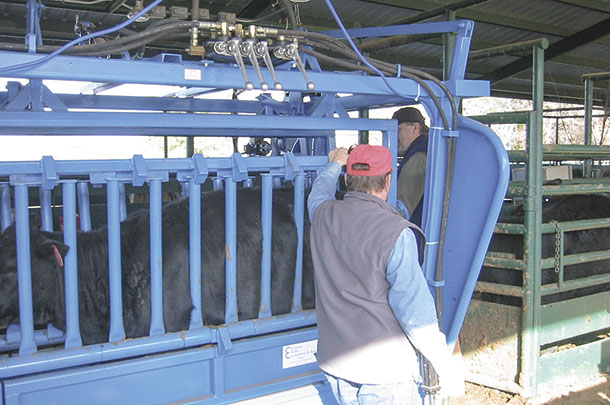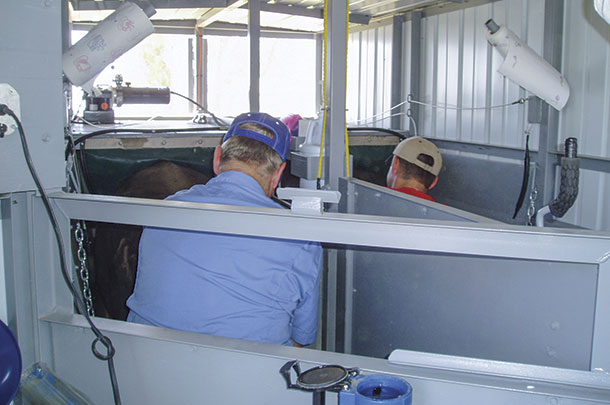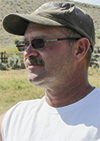Today, many commercial and seedstock producers are discovering the advantages of performing estrus synchronizing, A.I. and embryo transplanting of their cattle under the protection of a permanent barn/shed structure or in a portable breeding barn.
Carl Rugg, president and owner of Bovine Elite LLC in College Station, Texas, says, “The proper design and construction of an A.I. facility is critical to reducing stress and injury to the cattle being worked. A.I. facilities that are in a barn, shed or under a cover with open sides need to be an efficient and safe working environment for the humans working and breeding the cattle. This will result in optimal success for the A.I. program.”
Size and cover
It is important to have sufficient cover over the specific area where the A.I. process is being conducted in order to shield the cow or heifer and the A.I. technician from the weather. Producers in areas of the country that experience extreme cold temperatures might consider a closed-sided barn or shed but provide large enough doors to allow cattle to enter and exit as necessary.
An enclosed building conveniently allows personnel to enter and exit the shed or barn without disrupting the A.I. process or cattle movement.
Rugg says, “There are even times in Texas we could use more protection from the weather than is afforded from just a permanent cover over the A.I. facility.”
The actual size of the shed or barn can range from a facility large enough to cover all of the pens, tub, alley and chute or breeding box needed to protect all of the cattle you intend to work in a day to something as small as a portable breeding barn parked in front of a tub and alley outdoors.

Many producers chose to compromise by constructing partially enclosed barns or sheds. These start near the front of the alley, cover the breeding box or squeeze chute and extend a short distance past the exit door of the breeding box or headcatch of the squeeze chute.
What goes inside
Regardless of the size of your shed or barn, you need to have adequate room around the breeding box or chute to allow for the A.I. equipment, semen tank and other miscellaneous items required to perform the job. Allow adequate room to safely operate the breeding box or squeeze chute and enough room so the crew is not running into one another or obstructing the flow of cattle through the facility.
Rugg says, “Set your breeding box or chute in place and build your shed or barn around it to meet the space needs for equipment, labor, protection from inclement weather and provide adequate air flow. It is important to give yourself enough space to handle any unfortunate situation with a down animal that makes it necessary to release the animal by other than normal procedures.”
Rugg suggests having power, adequate lights, heat for cold weather and shelves to accommodate the A.I. kit, records, laptop, semen-thawing unit and ice chests. It is also a plus to have a dependable water source with enough pressure to hose down the facility throughout the day or at the end of each day to prevent a buildup of dirt and manure. If you keep expensive equipment in the facility, it is wise to have cabinets that can lock.
Jack Holden, owner of Holden Herefords, located outside of Great Falls, Montana, says, “Our A.I. barn is about 16 feet wide by 24 feet long. It is a metal-sided pole barn with the sides enclosed. We added Styrofoam insulation to the inside of the metal to help hold in some of the heat. When it is really cold and windy, we close in the ends of the barn with tarps.
We have a permanent electric heater we use for cold weather, and that helps a lot. We flush the cows and implant embryos for our fall calving program in November and December, and it is not uncommon to see some -10 to -20 degree Fahrenheit days. We also get a lot of wind off of the eastern slope of the Rocky Mountains and, even on a warm day, it can be miserable handling semen and embryos without the barn.”
Holden suggests a concrete floor with a roughened surface around the working area of the barn and under the breeding box or squeeze chute. He recommends placing a heavy rubber mat in front of the chute to give cattle footing as they exit. The mat should be about 8 feet in length.
Also, if you are constructing a small enclosure, the building should extend at least 8 feet in front of the headcatch. This will allow room for the rubber mat and gives the crew room to work around the front of the cow safely without putting extra pressure on the cow.
Holden says, “If they do come out a little hot or fast, the rubber mat allows them to get their feet under them before they hit the dirt outside the barn.”
Doubling up
Another option available to producers is the portable double-breeding barn. These steel barns are built on a frame. They are set up with an axle and hitch to allow the producer to attach the barn to a pickup and move it to any desired location.
 Neil Sorenson, owner of Sorenson’s Powder River Ranch near Gillette, Wyoming, says, “We use a portable double-breeding barn to A.I. our heifers. We back the barn directly in front of the tub and alley. It has a sliding door to allow the heifers into the barn. Inside there are two breeding boxes side by side.
Neil Sorenson, owner of Sorenson’s Powder River Ranch near Gillette, Wyoming, says, “We use a portable double-breeding barn to A.I. our heifers. We back the barn directly in front of the tub and alley. It has a sliding door to allow the heifers into the barn. Inside there are two breeding boxes side by side.
The A.I. technicians swing a door left or right, depending on which box they want the heifer to go into. The breeding boxes are very dark with rubber belting at the back to help block out light. Once the heifers are in the darkened box, they are quiet and calm.
When the A.I. tech is done with the heifer, he releases the door in front of the heifer, and she exits the box – entering the pen with the rest of the inseminated heifers.”
Dale Meek, purebred manager for Riverbend Ranch located in Idaho Falls, Idaho, says, “Our A.I. barn at Dillon, Montana is about 200 feet by 75 feet – big enough to hold a tub and alley and a squeeze chute. When we need to A.I. a large group of cattle, we can bring in a portable double-breeding barn and use two A.I. techs.
Although we are set up to run a lot of cattle through this facility, we have found smaller groups handle better and stay more quiet. We generally do not bring in more than about eight cows at a time. The rest of the cattle stand in sorting pens directly behind the barn until we bring them in to be worked.”
Meek says, “Quiet cattle handling is a big priority for Riverbend. We get a lot of wind at the facility near Dillon and, on a windy day, cattle really settle down once they get inside the building.”
This movement to provide protection for the cattle and the A.I. crew is another example of how cattlemen across the nation are implementing changes to their cattle-handling techniques in order to reduce stress and improve working conditions. Improving the beef industry – one step at a time. ![]()
PHOTO 1: A portable breeding barn set up in front of a tub and alley. Photo provided by Lex Carter, STgenetics.
PHOTO 2: A team A.I.’s cows under an open-sided barn in Texas. Photo provided by Carl Rugg, Bovine Elite LLC.
PHOTO 3: Two A.I. techs inseminate cows in a portable double-breeding barn. Photo provided by Lex Carter, STgenetics.
Michael Thomas is a freelance writer based in Salmon, Idaho. Email Michael Thomas.







